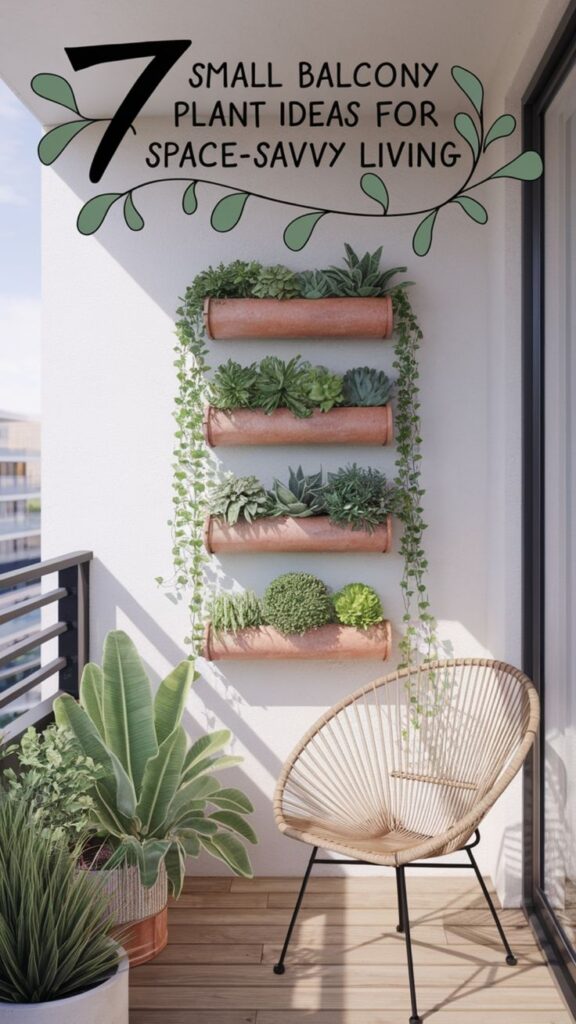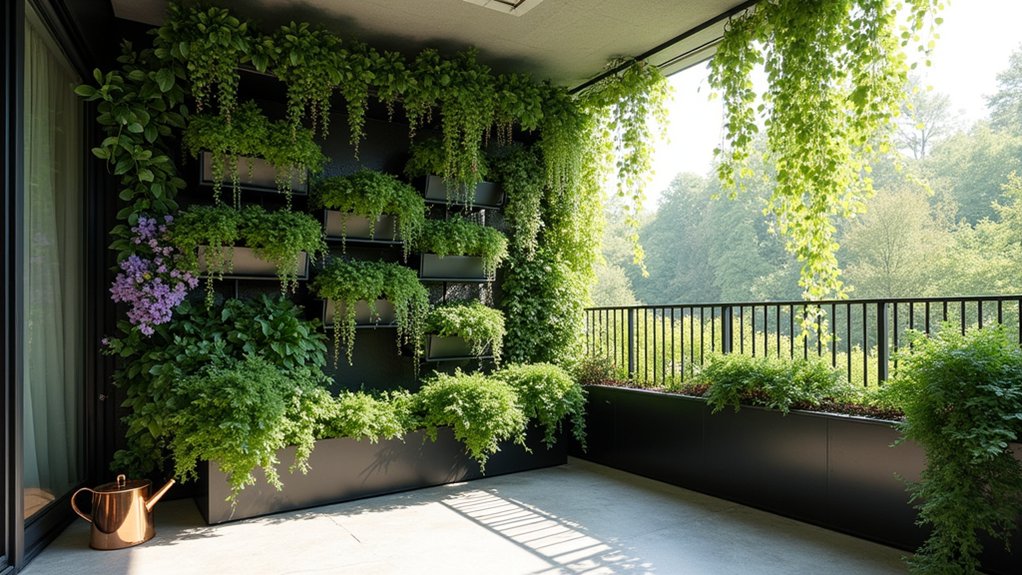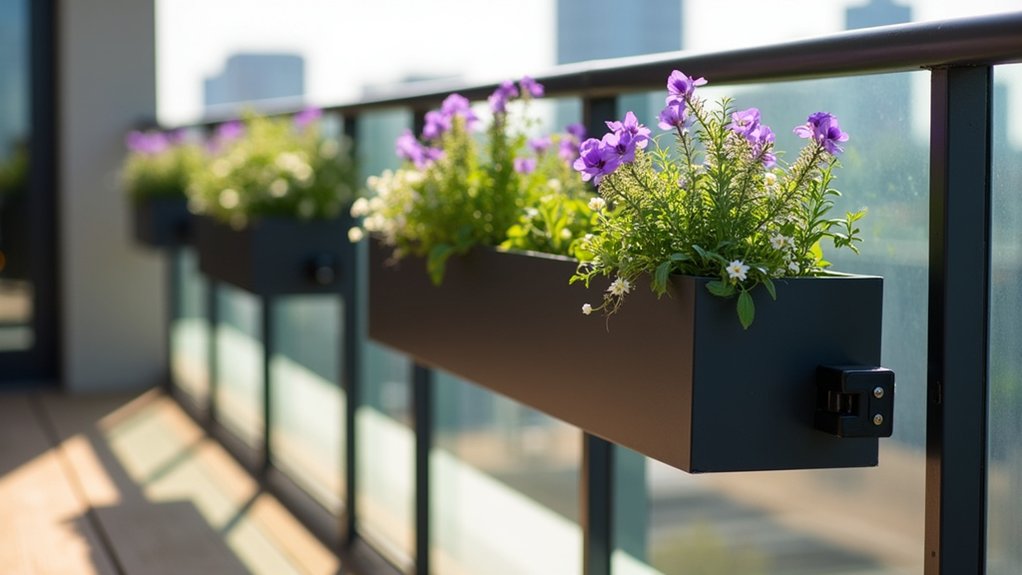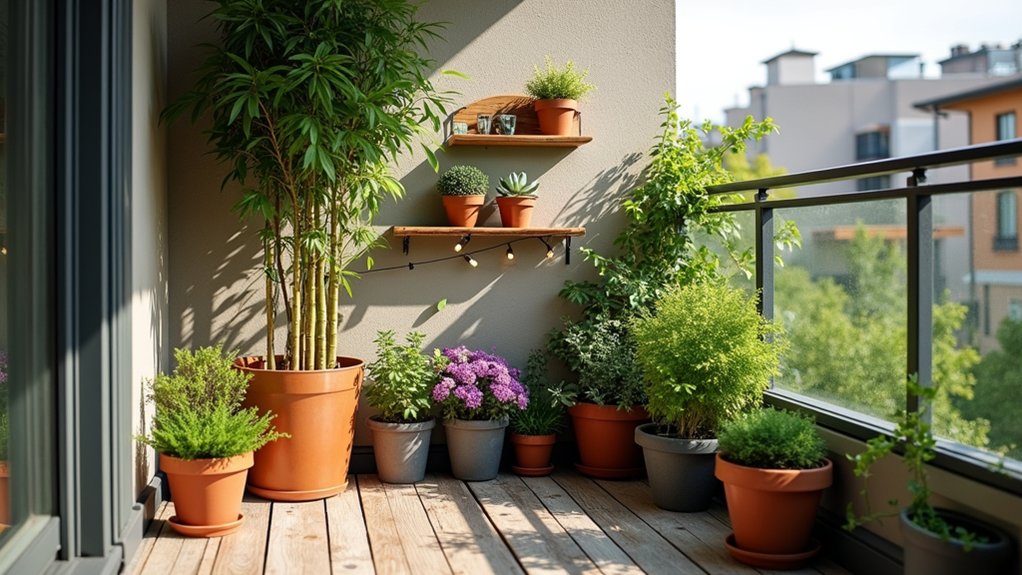You don’t need a sprawling backyard to create your own botanical oasis. Even the smallest balcony can transform into a thriving garden space with strategic planning and creative solutions. Whether you’re aiming to grow fresh herbs for cooking or create a peaceful green retreat, these seven space-maximizing ideas will help you utilize every square inch of your compact outdoor area. From vertical installations to multi-level displays, you’ll discover how to make your limited balcony space work harder without sacrificing style or functionality.

Contents
Vertical Garden Solutions for Maximum Impact

Vertical gardens transform limited balcony space into lush, living walls by utilizing innovative mounting systems and stackable planters. These space-saving solutions can incorporate a mix of trailing vines, compact herbs, succulents, and flowering plants arranged in layers, creating a dramatic visual impact from floor to ceiling.
Whether using pocket planters, modular grid systems, or repurposed pallets, vertical gardens maximize growing area while adding architectural interest and natural beauty to small balcony spaces.
- Light requirements: 4-6 hours direct sunlight daily, though needs vary by plant selection; north-facing walls need shade-tolerant species
- Water needs: Regular monitoring as vertical systems dry faster than ground plantings; install drip irrigation when possible
- Soil composition: Well-draining potting mix enriched with slow-release fertilizer
- Container requirements: Sturdy mounting systems rated for weight when wet; containers with adequate drainage
- Climate considerations: Choose plants suited to local conditions; protect from strong winds
- Spacing needs: Allow 6-12 inches between plants depending on mature size
Maintaining a vertical garden requires regular inspection of mounting hardware and irrigation systems to ensure structural integrity and proper water distribution.
Prune plants routinely to maintain desired shape and prevent overcrowding, removing dead or yellowing foliage promptly to discourage pest problems.
Rotate containers periodically to ensure even growth, and refresh soil annually while checking for root binding.
During growing season, apply liquid fertilizer monthly to compensate for nutrients washing out during frequent watering.
Compact Herb Garden Essentials

A compact herb garden on a small balcony maximizes limited space while providing fresh culinary herbs within arm’s reach. Using vertical planters, tiered containers, or wall-mounted pockets creates a lush display of aromatic herbs like basil, thyme, mint, and rosemary.
These versatile gardens can be arranged in attractive combinations of textures and heights, with trailing herbs cascading over container edges while upright varieties add visual interest and depth to the space.
Light, Water & Soil Requirements:
- 6-8 hours of direct sunlight daily for most herbs
- Well-draining containers with drainage holes
- Soil mixture: 2 parts potting soil, 1 part perlite for optimal drainage
- Water when top inch of soil feels dry
- Container depth minimum 6 inches for most herbs
- Space plants 4-6 inches apart to prevent overcrowding
Regular pruning and harvesting are essential for maintaining a healthy compact herb garden. Trim herbs frequently to encourage bushier growth and prevent flowering, which can make the leaves bitter.
Remove any yellowed or damaged leaves promptly to prevent disease spread. During growing season, feed herbs monthly with a balanced, water-soluble fertilizer at half strength to avoid excessive leaf production that could compromise flavor.
Rotate containers periodically to ensure even growth, and inspect plants weekly for signs of pests or disease.
Space-Saving Container Combinations

Space-saving container combinations maximize limited balcony space by strategically grouping plants with similar care requirements in layered or vertical arrangements. These combinations typically feature a mix of trailing plants that cascade over edges, upright specimens for height variation, and compact plants to fill middle spaces. Popular pairings include herbs with flowering annuals, succulents with ornamental grasses, or vegetable plants with companion flowers.
- Light requirements: Minimum 4-6 hours direct sunlight daily, though specific needs vary by plant combination
- Soil needs: Well-draining potting mix appropriate for chosen plant types
- Container depth: 8-12 inches minimum for most combinations
- Spacing: 4-6 inches between plants, depending on mature size
- Water needs: Consistent moisture without waterlogging
- Temperature range: 60-80°F (15-27°C) for most combinations
- Fertilizer: Balanced, water-soluble feed every 2-4 weeks during growing season
Regular maintenance for container combinations includes monitoring soil moisture levels daily, as multiple plants in one container deplete water more quickly than single specimens.
Trim back aggressive growers to prevent them from overwhelming neighboring plants, remove spent blooms to encourage continuous flowering, and rotate containers quarterly to ensure even growth.
When selecting new additions, always group plants with similar growth rates and resource requirements to prevent competition and maintain visual harmony.
Hanging Plant Arrangements

Hanging plant arrangements transform small balconies into lush vertical gardens by utilizing overhead space and railing attachments. These arrangements typically feature cascading plants in suspended containers, wall-mounted planters, or railing baskets, creating layers of greenery that flow downward. Popular options include trailing plants like ivy, petunias, fuchsias, and string-of-pearls, which can be combined to create dynamic displays with varying textures, colors, and lengths.
- Light Requirements: Most hanging arrangements need 4-6 hours of sunlight daily; east or west-facing positions are ideal.
- Water Needs: Check soil moisture daily, as hanging plants dry out faster than ground-level containers.
- Container Requirements: Use lightweight containers with proper drainage holes.
- Soil Type: Well-draining potting mix specifically formulated for container plants.
- Spacing: Allow 12-18 inches between hanging baskets for proper air circulation.
- Weight Considerations: Verify balcony weight restrictions and use plastic or fabric containers instead of heavy ceramic.
Regular maintenance of hanging plant arrangements involves pruning dead or yellowing foliage, rotating containers weekly for even growth, and checking mounting hardware monthly for security.
Fertilize with a balanced, water-soluble fertilizer every two weeks during growing season, and trim trailing stems when they become too long or sparse.
During extreme weather, temporarily relocate arrangements to protected areas or add temporary wind barriers to prevent damage.
Railing-Mounted Planter Ideas

Railing-mounted planters transform balcony railings into space-efficient growing areas, maximizing limited outdoor space without compromising floor area. These containers typically feature sturdy hooks, brackets, or adjustable clamps that securely attach to railings, offering a safe and stable growing environment for plants.
Available in various materials like powder-coated metal, weather-resistant plastic, or ceramic, these planters can accommodate everything from trailing flowers to compact herbs and small vegetables.
- Light Requirements: Most railing positions receive 4-6 hours of direct sunlight; adjust plant selection based on specific exposure
- Water Needs: Requires more frequent watering than ground plants due to increased wind exposure and limited soil volume
- Soil Type: Well-draining potting mix with moisture-retaining properties
- Container Depth: Minimum 6 inches deep for most plants; 8-12 inches for vegetables
- Weight Capacity: Check railing weight limits; typically support 10-20 pounds per bracket
- Drainage: Must have adequate drainage holes and catch trays to prevent water damage
Regular maintenance of railing-mounted planters involves checking the security of mounting hardware at least monthly, especially after strong winds or storms.
Rotate containers periodically to ensure even growth, as plants typically lean toward sunlight. Trim back overgrown plants that might strain the mounting system, and inspect brackets for rust or wear.
During winter months in colder climates, either remove the planters or provide adequate protection to prevent damage from freezing temperatures and ice accumulation.
Corner Garden Design Strategies

Corner spaces on small balconies present unique opportunities for creating efficient and visually appealing garden arrangements.
A well-designed balcony corner garden typically features plants arranged in graduated heights, with taller specimens at the back corner and shorter ones cascading forward. This triangular configuration maximizes the often-underutilized corner space while creating depth and visual interest, utilizing vertical gardening techniques such as tiered shelving, corner trellises, or stacked containers.
- Light Requirements: Analyze sun exposure in the corner (most balcony corners receive either morning or afternoon sun)
- Spacing: Allow 6-12 inches between containers for proper air circulation
- Container Selection: Use lightweight, weather-resistant containers with drainage holes
- Soil Type: Well-draining potting mix specifically formulated for container gardens
- Support Needs: Secure all containers and structures against wind
- Weight Considerations: Check balcony weight restrictions before installing heavy containers
Regular pruning and shaping of corner garden plants help maintain the desired graduated effect and prevent overcrowding in the limited space.
Rotate containers quarterly to ensure even growth, as corner plantings may receive uneven light exposure.
Install a drip irrigation system or self-watering containers to maintain consistent moisture levels, particularly for plants that may be difficult to reach in tight corner spaces.
Monitor for pests more frequently in corner gardens, as the enclosed space can create favorable conditions for certain insects.
Multi-Level Plant Display Systems

Multi-level plant display systems are innovative space-saving solutions that maximize vertical growing area on small balconies. These systems typically consist of tiered shelving, hanging units, or cascading planters arranged at different heights, creating a dynamic visual effect while accommodating multiple plants in a compact footprint.
The structures can be made from various materials like wood, metal, or recycled materials, and often feature adjustable components to customize the arrangement based on plant sizes and growing needs.
- Position system where it receives 4-6 hours of direct sunlight daily
- Ensure proper weight distribution and secure anchoring to walls or railings
- Use well-draining containers with drainage holes
- Install system where it’s protected from strong winds
- Choose containers with appropriate depth for intended plants
- Maintain 2-3 inches between plants for adequate air circulation
- Select lightweight potting mix to reduce overall system weight
Regular inspection of the support structure’s stability and hardware is essential for maintaining a multi-level display system.
Check mounting brackets, screws, and weight-bearing points monthly, adjusting as needed to prevent shifting or sagging. Clean the surfaces and gaps between levels to prevent moisture buildup and potential pest issues, and rotate plants periodically to ensure even growth and light exposure.
When rearranging plants, consider their mature sizes and growth patterns to maintain the display’s aesthetic balance while preventing overcrowding.
